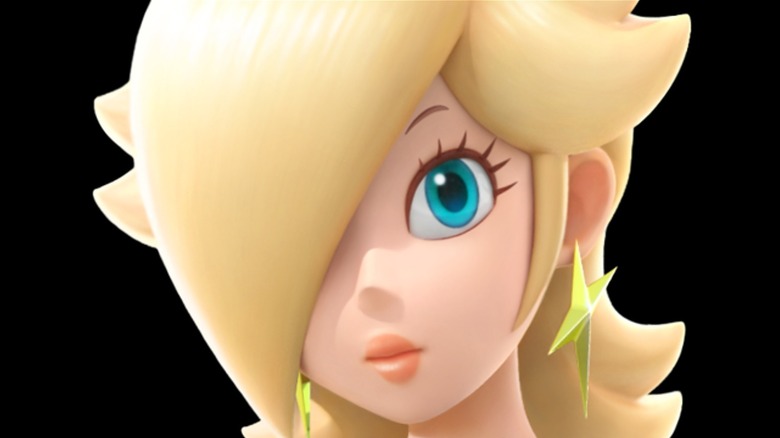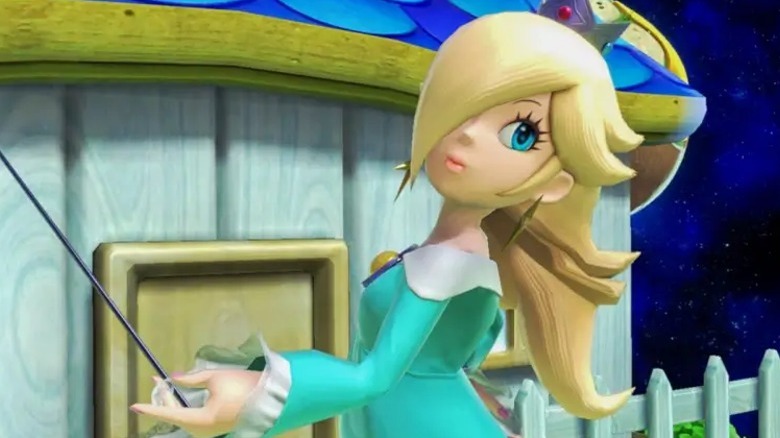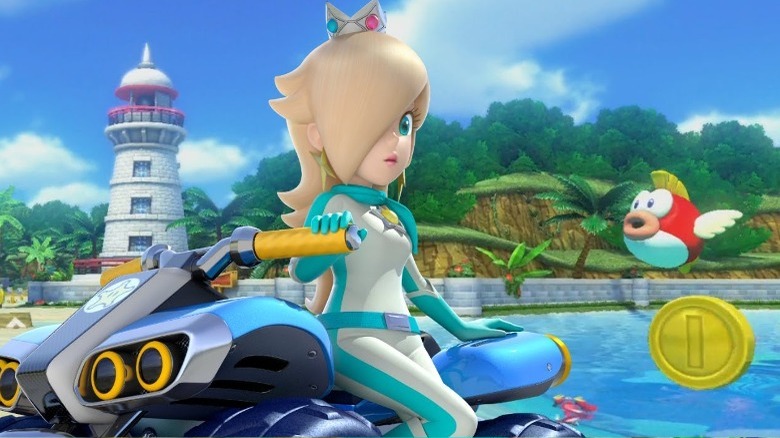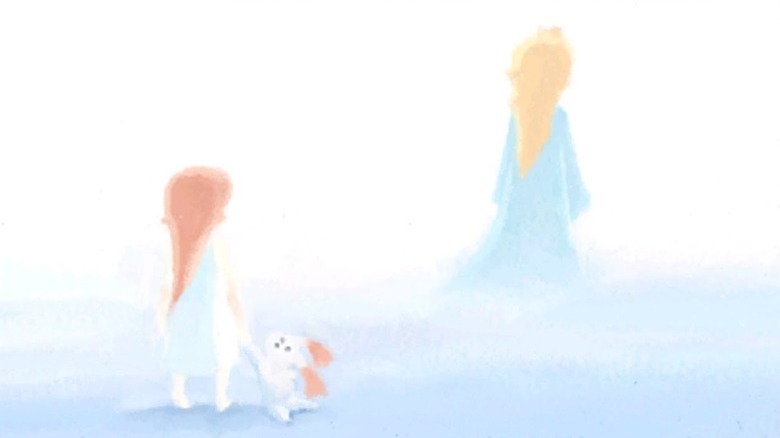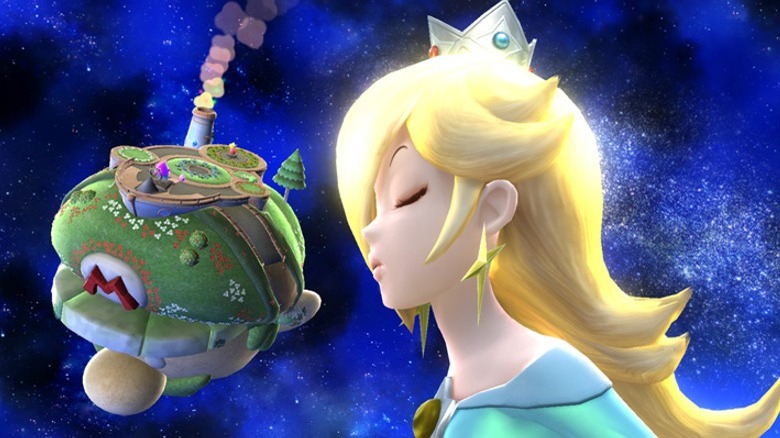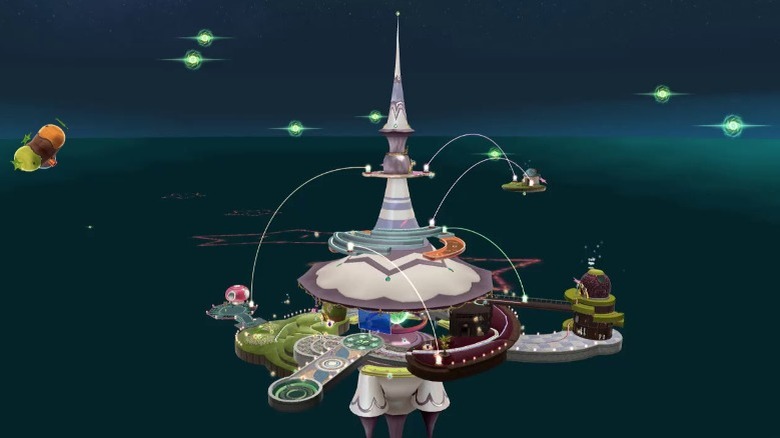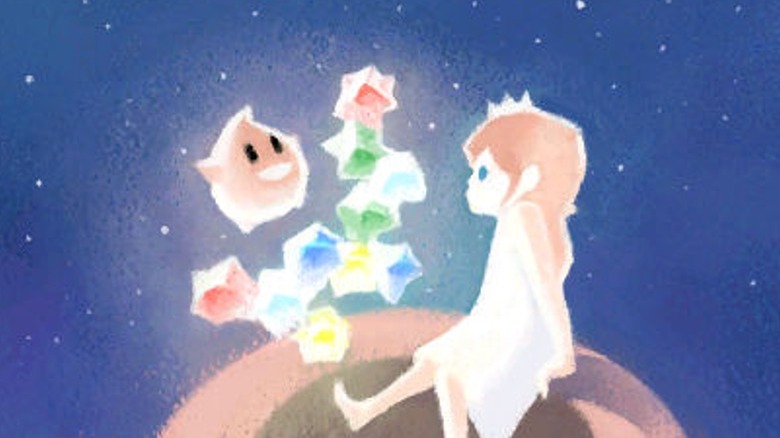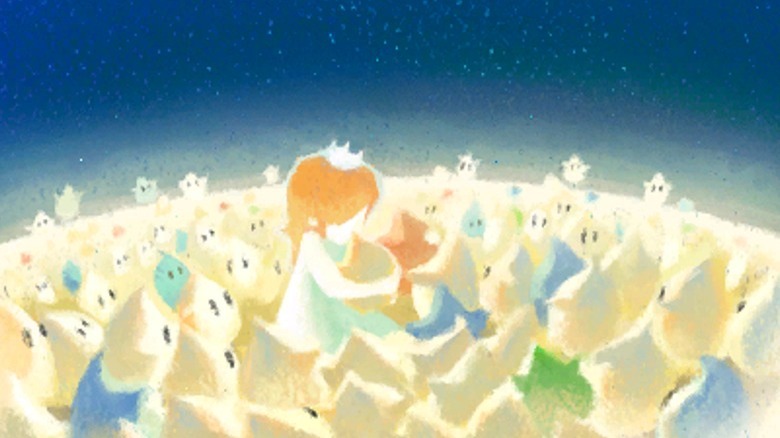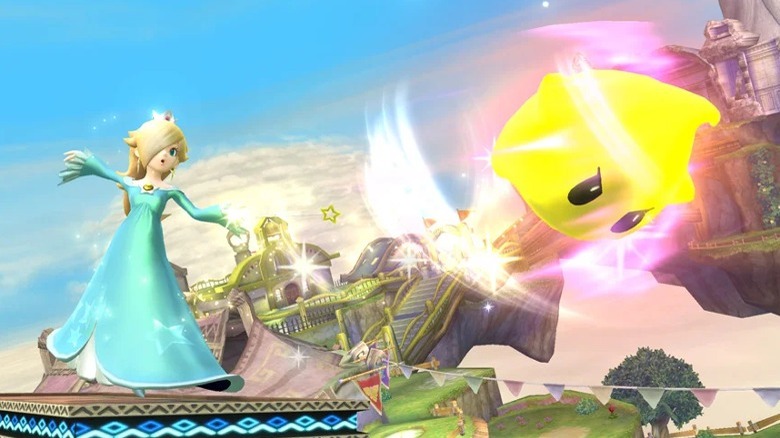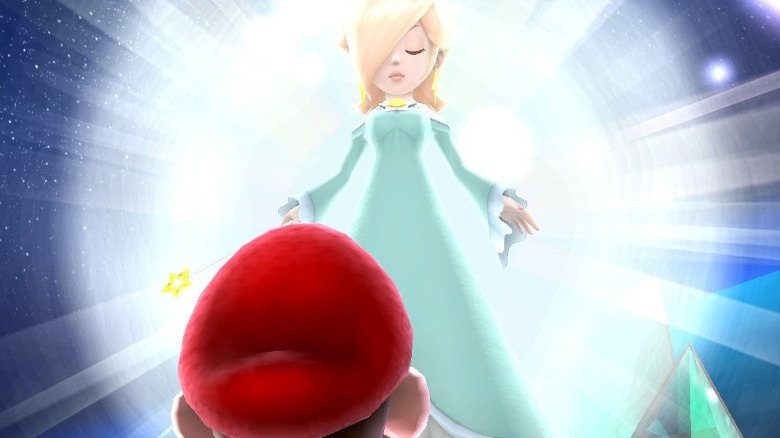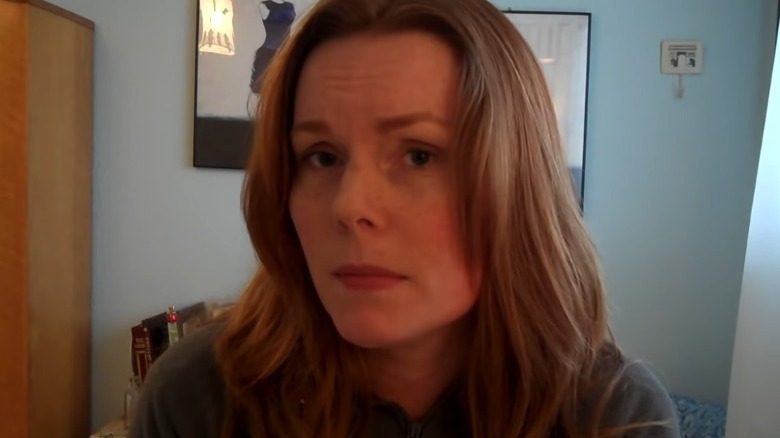Things Only Adults Notice About Rosalina From The Mario Games
There are a few details about Rosalina from the "Mario" games that some fans might not immediately notice. Nearly all of the games that Nintendo has developed for the franchise have been targeted at gamers of all ages, but some ideas and concepts are less likely to be picked up on by younger players.
Rosalina was first introduced in "Super Mario Galaxy," which came out back in 2007. This makes her a relatively recent addition compared to the other princesses in the franchise, but a fair amount of information has already been established about her in the handful of titles in which she makes an appearance. In fact, Nintendo has already developed a much deeper backstory for her than most characters in the "Mario" universe.
Rosalina actually hails from the Mushroom Kingdom, like Princess Peach, but she left her home world to explore the stars alongside a Luma who crash-landed there, promising to help the poor stranded creature get back to its mother. Over the course of this journey, Rosalina came to meet several other Lumas, built the Comet Observatory, and became a central character in several adventures featuring a certain mustachioed Italian plumber. Since then, she's also been featured in the "Mario Kart," "Mario Party," "Mario Golf," "Mario Tennis," "Mario Sports," and "Super Smash Bros." franchises. In that time, Nintendo has developed some aspects of her character that only adults are likely to notice.
Rosalina is kind of a scene kid
Princesses Peach and Daisy both have hairstyles that are bouncy and fun, but fairly conservative. One of the first things that many players might notice about Rosalina's design is that she sports a much more alternative fashion sense. She has long, straight bangs that cut a swath across the side of her face, obscuring her right eye. Variations of this haircut have been coming back in style lately, but it was particularly popular during the early-to-mid aughts — around the same time period when "Super Mario Galaxy" was in development.
The developers made a few notes about the initial concept for her character in the "Super Mario Galaxy Prima Official Guide," remarking, "Her long bangs represent her outward strength and inner sorrow and loneliness." That's a lot of narrative weight to be carried by a haircut, but those fans who were around when the emo and "scene" styles were heavily perpetuated by bands like My Chemical Romance and Panic! At the Disco are much more likely to understand exactly what the developers meant by that. While it doesn't do much for a person's depth perception, the haircut illustrates a dramatic sense of melancholy that fits perfectly with Rosalina's character.
Rosalia's a heavyweight racer
There are several different weight classes in the "Mario Kart" franchise. Light characters have faster acceleration and are much less heavily affected by crossing off-road terrain. Heavy characters accelerate slowly and struggle with going off-road, but have a much higher top-speed. Then there are the medium-weight characters, who are something of a balance of the two.
Rosalia is considered a heavy character, making her the first — and so far, only — female heavyweight in the franchise. Some fans initially attributed this to the fact that she rode with a Luma in "Mario Kart Wii," as the space creature may be extremely dense and therefore offset the weight. The Luma is not present in later games, however, and Rosalina maintains her higher weight class. She's taller than medium-weights Peach and Daisy and is certainly larger in stature than the light-weight Toadette, but she still appears to be much lighter than the other heavyweight characters such as Bowser and Donkey Kong.
Most of the tall and lanky characters, like Luigi, are considered medium weight. That might lead some of the more experienced gamers to think that it's more likely Nintendo simply chose to bump her up to heavyweight class in order to spread out the female characters among the different weight classes. This makes sense, as it would allow players who prefer to race a female character to have more options in terms of how the characters actually handle. Kids probably aren't going to put nearly as much thought into the weird physics of "Mario Kart" classes, though — and Rosalina doesn't seem to be bothered.
Rosalina's story has heavy themes of motherhood
There is a famous scene in "Super Mario Galaxy" in which Mario finds Rosalina in the library of the observatory, and it's a doozy. She's reading a storybook to the Lumas, which tells the tale of how she left her home and came to build theirs. This story is heavy with themes of motherhood and found families.
It begins with Rosalina finding a Luma in a crashed starship, crying because they're unable to find their mother and claiming that she is coming for them. Rosalina promises to wait with Luma, but decides after a while that going out into space and searching for her would be more effective. They don't find Luma's mother, but instead end up settling on a comet.
Rosalina starts having dreams about her own mother after a while. "Don't fret, dearest," Rosalina's mother says in the dream. "I'm not going anywhere. I'm always watching over you, like the sun in the day and the moon in the night." After this, Rosalina wakes up in tears, full of remorse at the realization that her journey has taken her so far from home that she will likely never see her own mother again.
As she comes to grips with the idea that neither she nor Luma are likely to find their mothers again, she decides to adopt all of the Lumas. It's this notion of found family and taking on the role of motherhood that saves Rosalina and helps her overcome her sorrow. This is definitely a story that resonates differently with adults who are old enough to be parents themselves, or have found comfort in a family outside of their biological one.
Rosalina can breath in space
Pointing out the scientific impossibilities in a Nintendo game isn't exactly difficult, but "Super Mario Galaxy" takes its disregard for basic physics a lot further than most of the games in the franchise – especially when it comes to space travel. Rosalina and Luma's journey begins with her repairing the star-child's space ship, but it quickly becomes apparent that the vehicle is just a means of transportation and that neither of them need it for any kind of life support. In fact, the ship actually has open windows, which Rosalina sticks her head through as they leave the stratosphere.
Forget the lack of oxygen; apparently these characters are also immune to extreme variations in temperature and solar radiation that could break down most organic life forms at a molecular level. They even decide to build their home on a comet made entirely of ice.
One could attribute this to her magical abilities, but she isn't the only one shown doing this. Mario himself spends a good deal of the game wandering around in the vacuum of space without any sort of protective suit. It seems that there are two possibilities: either the residents of the Mushroom Kingdom have a Kryptonian-like tolerance to the dangers of space, or outer space itself is a much less hazardous environment in the "Super Mario Galaxy." We may never know.
Home ownership on a comet
One of the more ambitious challenges that Rosalina faces on her space adventure is that of home ownership. It can't be easy to settle down and build a homestead on a comet. (Not sure what the school districts are like on the fringes of the galaxy, but at least it isn't in an HOA.)
It isn't just any home either, the Comet Observatory has some fantastic amenities, including a terrace, fountain, kitchen, bedroom, engine room and even a space garden. Setting aside Rosalina's impressive architectural acumen, adults might see the observatory itself through a slightly different lens.
A kid might look at that and think of the majesty of a whimsical mansion drifting amongst the stars, whereas an adult would probably be wishing they could find a listing that good on Zillow. Sure, the commute might be a tad excessive, but it's hard to argue with the property value (especially in this economy). Living in such a remote location means that Rosalina and the Lumas probably have to do most of the upkeep themselves, but it's good to know that there's at least one plumber willing to make the trip.
A healthy diet of Star Bits
Kids might think they can subsist on a diet of sugar cereal and fruit roll ups, but adults know a balanced diet is an essential part of a healthy lifestyle. Upon leaving the Mushroom Kingdom, Rosalina states that she had packed "all the essentials: telescope, butterfly net, stuffed bunny, bread, milk, jam and apricot-flavored tea," but that she forgot to bring water. Then Luma laughs and tells her, "As long as I have Star Bits, I'll be fine."
Most people would probably question the decision to eat a bunch of space rocks handed to you by a sentient alien star baby, but Rosalina isn't like most people. She claims that they taste like honey and seems fine with the fact that her diet will exclusively subsist of sweet, sweet Star Bits for the rest of her life.
But what exactly is the nutritional value of a Star Bit? A sweet-tasting rock candy certainly doesn't sound very rich in protein or fiber. Does it have all the necessary vitamins and minerals, or is it just a matter of time before Rosalina starts to suffer from space scurvy? What about Omega-3 fatty acids? It's hard enough to get those into your diet on Earth. This makes Mario's habit of eating strange, brightly colored mushrooms that he finds in mystery boxes feel a lot less reckless by comparison.
No adoption papers needed
Another of Rosalina's antics that cause some adults to do a double-take is her decision to adopt all of the Lumas. It begins with her promising to take care of the one she's been traveling with, but she realizes after building the Comet Observatory that it feels too big and empty for just the two of them. As if in answer to her prayers, dozens more Lumas arrive at the observatory and start to call her "mama." She then decides to give them all names and adopt them.
This is all well and good for a children's storybook, but just imagine if a few dozen kids showed up at someone's house in real life and that person simply decided that they were adopted. Seems like there would be a lot more paperwork involved. To be fair, there probably aren't any sort of government-mandated adoption regulations in outer space, and Rosalina was clearly able to give them a magnificent home full of all the Star Bits they could eat. Still, just up and deciding to take responsibility for a whole gaggle of children you just met is a bit beyond the pale. It's also strange that the story establishes that the Lumas already have a mother who they were separated from; they were simply unable to find her.
Rosalina forces her child to fight with her
It turns out that Rosalina might not be the best caretaker for a gaggle of star babies, however. Her character appears on the rosters in "Super Smash Bros. 4" and "Super Smash Bros. Ultimate," but she doesn't fight alone. Both of these games feature her fighting alongside one of her Luma children.
Admittedly, Nintendo doesn't have the best track record when it comes to publishing games that force small innocent creatures to fight (just look at "Pokémon"), but it seems particularly egregious to spend so much of Rosalina's backstory building her up to be this loving maternal character and then having her take her children into battle. Worse yet, many of her moves in both of the games literally involve her throwing her own child at her enemies. Her shield also only covers herself, leaving Luma vulnerable to incoming attacks. Even Bowser treats his kids better than that.
To be fair, Luma isn't the only minor to take part in "Super Smash" battles, as about a third of the "Ultimate" roster look like they're probably too young to vote. Still, none of the others look like they're being actively dragged into the fighting pits by their own mother.
She doesn't seem to care that her children sacrifice themselves
Forcing her kids to fight isn't the worst parenting practice Rosalina exhibits in the franchise, either. That comes at the end of "Super Mario Galaxy."
See, Bowser creates a black hole after Mario defeats him and rescues Princess Peach. This cosmic void of destruction threatens to pull in everything nearby, including Peach, the observatory, and Mario himself. But before that can happen, all of the Lumas nobly sacrifice themselves by hurling their bodies into the black hole, causing it to implode before it can devour everything.
Rosalina then appears to Mario, bathed in the light of the explosion amid the sound of crying infants. She actually laughs after she just watched all of her children sacrifice themselves to save the galaxy and says, "When stars die, they turn to stardust and scatter across the cosmos. Eventually that stardust reforms to create a new star... and so the cycle of life continues."
That's a very new age way of looking at the death of your own adopted children, but it seems more than a little cold that she doesn't seem to express even the slightest remorse at their demise. Even if new Lumas are born from their ashes, that doesn't change what happened to the ones who sacrificed themselves, right? Most parents playing the game — or watching their kids play — might pause the cutscene in abject horror.
Rosalina's original voice actor is in The Haunting of Sunshine Girl
There's one more detail about Rosalina that older fans might have noticed, but this one has more to do with one of the actors who played her. Multiple voice actors have portrayed Rosalina across her numerous appearances, but the first one to bring life to the character in an english-speaking soundtrack was Mercedes Rose.
In addition to her work as the Nintendo space princess, Rose also played Sunshine's mother Kat Jones in "The Haunting of Sunshine Girl;" a paranormal web series that she co-created in 2010 and which quickly went viral. The show was fashioned as a faux-docuseries, in which 16-year-old Sunshine moves into a self-proclaimed "haunted house" in Washington and documents the various supernatural events taking place there. The original series struck a chord with audiences, riding the wave of popularity enjoyed by similar media following the success of "The Blair Witch Project," but with a slightly less serious tone.
Kids would probably find "The Haunting of Sunshine Girl" to be more than a little hokey by today's standards, but it's difficult to explain the feeling of discovering Sunshine's journey on the internet back when the series first began, when it was hard to tell if it was real or not. Truly, you just had to be there. Mercedes Rose played Kat across all 14 seasons of the web series, and so many fans from the show's heyday might have recognized her voice as Rosalina.

